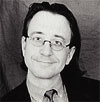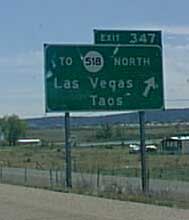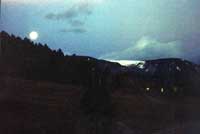
Hank Dittmar directs the Transportation and Quality of Life Campaign of the Surface Transportation Policy Project, a coalition of environmental and community groups working to reform transportation policy.
Tuesday, 1 Jun 1999
LAS VEGAS, N.M.
It’s been just about a year since my wife and I packed up our house and our infant twins and moved from Washington, D.C. to northern New Mexico. I’d just completed a five-year stint as executive director of the Surface Transportation Policy Project, a big coalition of national and grassroots environmentalists, social justice activists, and community-minded people who’d sought since 1990 to reform the nation’s transportation policies.

Seeking his fortune in Las Vegas.
STPP works on three aspects of transportation reform: addressing the direct environmental consequences of driving (air pollution, greenhouse gas emissions, death and injuries to drivers and pedestrians); the direct environmental and human consequences of road-building (the destruction of neighborhoods, towns, scenic and historic resources, the loss of farmland and habitat, and the noise and water pollution from roads); and the indirect impacts from land development and traffic induced by roads — metropolitan and rural sprawl.
My last day at work in D.C. was the day that both houses of Congress passed the Conference Report on the mammoth TEA-21 (the transportation policy and spending blueprint for the nation for the next six years) so it was a fitting time to blow town. We’d succeeded in defending and even extending the reform efforts begun in 1991 with the bill’s predecessor, so that virtually none of the money in the $217 billion bill was dedicated for new or wider roads and increased amounts were dedicated to transit, bicycle, and pedestrian transportation, historic preservation, scenic and historic resource protection, and fixing existing roads. At the same time, the bill dedicated more money to transportation than ever before, and the flip side of the fact that it wasn’t dedicated to new roads was that many of the state highway agencies still wanted to spend it on expanding existing roads. Few states were ready to use this flexibility in positive ways, and the next challenge clearly was to get out of D.C. and devote my energies to the grassroots level.
So I’m now directing STPP’s Transportation and Quality of Life Campaign from an office in Las Vegas, New Mexico, and living in a mountain village off a dirt road. I joke that the first step in our Quality of Life campaign was to improve my own quality of life, and I’ve certainly managed that, although the balance of travel and a new family has proved an uneasy one at times.
Here in New Mexico, we’ve seen the good and the bad of the new transportation bill. On the plus side, our local 1889 Santa Fe Depot, host to daily Amtrak service, is getting restored as a train/bus terminal and visitor’s center thanks to TEA-21’s transportation enhancement center. And our savvy Citizens’ Committee for Historic Preservation got a $315,000 scenic byways grant to develop an interpretive center about the Santa Fe Trail and to do a feasibility study for bike and pedestrian access along the trail, which goes right through town. Similar projects are springing up all over the state, including light rail in Albuquerque and commuter rail in Santa Fe!
On the debit side, the state used new authority to bond against future federal receipts, to finance some 500 miles of new or wider roads. I’ve been hearing from citizens all over the state. In the little town of Hondo, citizens are concerned about a proposal to widen a lightly traveled two-lane road from Ruidoso to Roswell (for “economic development” purposes). In historic Rancho de Taos, a four-lane highway threatens a little community and the church made famous by Georgia O’Keefe. And in the Raton Pass, which connects New Mexico and Colorado along I-25, needed maintenance has ballooned into a big project, which threatens the Santa Fe Trail overlook, and perhaps some of the trail ruts.
This week will be a busy one for me as I juggle the local, statewide, and national aspects of my work. Today, I’m working on a proposal to use the train depot revitalization as a catalyst for revitalizing the entire railroad district here in Las Vegas, a town with over 900 buildings on the National Register of Historic Places. Later in the week I travel: first to Denver for a much-needed effort to develop an urban/metropolitan agenda for the presidential elections; and then to Milwaukee for the annual meeting of the Congress for New Urbanism, a gathering of the best minds in design and place-making that is responsive to people and nature. Glad to have you all along!
Wednesday, 2 Jun 1999
LAS VEGAS, N.M. (NOT Nevada)
This past Memorial Day weekend was a beautiful one here in northeastern New Mexico. Late spring and early summer in the Sangre De Christo range can be windy and unpredictable, and indeed on the way home on Friday I had to take refuge under a tree when golf-ball-sized hail began to fall. Saturday was crystal clear and the temperature was in the seventies — perfect weather for the barbecue and campout planned that day.

Toto, we’re not in D.C. anymore… the view from Hank’s room.
We joined Arturo Sandoval, Ned Farquhar, and their families in the late afternoon at some property Arturo owns at 8,800 feet in the mountains above the village of Chacon, where Arturo’s grandfather established the El Rito Presbyterian Church in the early days of this century. Ned Farquhar is a long-time environmental activist who directs the smart growth group 1000 Friends of New Mexico and Arturo runs a consulting company called VOCES and serves on the 1000 Friends board. We watched the kids play, listened to Arturo’s 88-year-old dad reminisce about growing up in rural northern New Mexico, and ate carne asada, green chile stew, and roasted corn. Over dinner I learned that Arturo had been a VISTA volunteer in the area until he left to help Denis Hayes organize the first Earth Day among the Chicano community in 1970.
In 1970, I was in high school and Earth Day was a defining event. A few years ago, when cleaning out some boxes at my parents house, I came across an essay I’d written in 1970 about environmentalism. Not only was I struck by the fact that I was much smarter then, but also by how little some of my defining principles had changed in almost 30 years. The essay stressed the importance of grassroots activism and public education in bringing about change. Much has changed in the past thirty years, but not the central lesson — that we can win battles through court challenges and good science, but that lasting change will involve committed local action and public understanding.
One of the things that has evolved in the environmental movement in the past 30 years has been a professional class of environmentalists. We have gained much from this development, for environmental problems are technical, legal, and global, and we need individuals who can interact with societal structures at all those levels. But the development of environmental professionalism has opened up a big gulf between New York- and Washington, D.C.-based groups and committed citizens, and when I moved to Washington to take over STPP, I learned that local groups were concerned about national groups passing legislation, winning court victories, and then presuming that things had changed. In fact, legislative
and legal victories most often only provide the framework for implementation. Successful implementation requires action on the ground and that requires organizing, public education, political involvement, and resources.
And most often compromise and the ability to listen are at the top of the list, too. Arturo, Ned, Judith Espinosa of the National Wildlife Federation board and I are trying to put together a smart growth coalition for the state of New Mexico, and we want very much to create a coalition that embraces all the facets of the smart growth/sprawl issues: loss of habitat, farmland, and ranch land to development; the threat to traditional ways of life and local business from the Walmart-ing of rural America; abandonment and loss of economic opportunity in center cities, low-income neighborhoods and communities of color; and public health impacts of air pollution and water pollution from automobiles and industry.
Smart growth is often seen as a white, suburban issue, concerned mainly with open space at the edge of our cities. To get beyond this, we have to frame the issue properly and to do this we have to invite the right people to the table. And we have to evolve a new human-environment equation, recognizing that traditional people living on the land have environmental awareness of their own. Here in New Mexico, water is a key issue and environmental concerns about in-stream flow in the rivers have led to conflicts with tiny Spanish villages that irrigate their fields from centuries’ old acequias, or ditches. Rather than creating conflict with these small farmers and ranchers, it seems to me that the environmental community ought to propose common cause against the cities whose profligate water use and unrestricted development policies are leading to huge increases in water use. Helping to defend the water rights of the land grant villages seems to me a natural alliance. Hopefully, our coalition can help make these bridges. We think we’ve invited the right folks to join.
Today I’m going up to Denver to meet with leadership of the U.S. Conference of Mayors along with smart people from the Brookings Institute and the National Trust for Historic Preservation to talk about an urban agenda for the presidential election. In the process I’ll be burning a lot of carbon in the air and on the ground — one of the great contradictions of trying to work globally and locally. More about that later.
Thursday, 3 Jun 1999
DENVER, Colo.
I spent yesterday morning at home mixing work and family, and then drove to Albuquerque (2 hours), flew to Denver (1 hour and a half), and took a shuttle from Denver’s massive new airport to downtown (1 hour and a half, counting hassles). In retrospect, I could have driven here in the same amount of time.
I do a lot more driving out here than I did in either D.C. or San Francisco, the two cities I’ve lived in most recently. Obviously, there’s no transit to speak of and my house is too far away and the trip too mountainous for walking and bicycling. We try to cope by making as few trips as possible (bunching trips together), walking and bicycling when I’m at my office in town, and ensuring that we have vehicles that are at or near the top of the fuel-efficiency chart for their class. And I joke that I’m using some of the credits I earned in 20 years of being a non-driver.
For years when I’d make speeches at transportation gatherings I’d encounter hecklers, usually highway engineers from Kansas, the Dakotas, Utah, or some other rural state. They’d accuse me of being an Easterner or West Coast city dweller, who wanted to force people out of their cars and who lacked understanding of how essential cars are in their state. Actually, the data show that rural people rank second in the driving sweepstakes, behind suburbanites and ahead of city dwellers. The reason is that many people living in small towns or the country tend to make one shopping trip to town with many stops, while suburbanites tend to make many, many small and medium-sized trips. Also many people in small towns or the country have home-based work, either in farming or ranching or simply out of home- based businesses. Finally, walking trips are a higher percentage of the total in small towns, as many of them are still designed around main streets, with walkable residential neighborhoods nearby.
While autos are a big part of life out here, so is auto-based death. For example, New Mexico leads the nation in both drunk-driving deaths and pedestrian deaths. And many of our state highway departments seem to be dedicated to doing their best to make people more reliant on their cars, not less reliant. Whenever possible, they seem to build roads that speed up cars and destroy communities in towns and cities, not slow them down so that pedestrians have a fighting chance. The state is widening the four-lane arterial outside my office and taking away parking. The result will be that people will drive faster through town and both walkers and the area merchants will suffer. We seem bent on replicating the suburban model everywhere, even on Main Street, where it is least appropriate.
Denver is a study in contrasts. They put their big new airport way, way out of town on the plains, so that you have to drive through farmland for some time before reaching the city. The theory was that this would insulate it from incompatible uses, yet the airport’s already attracting development, which springs fully formed in the middle of wheat fields. Last month, I took a group of elected and appointed officials on a study tour of European approaches to land use and transit, and I found one difference particularly striking: Whether in cities or towns, the Europeans have maintained distinct edges between city and countryside, and the result is they have plenty of both. We have blurred the distinction with sprawl, and the result is that from an efficiency and environment perspective, we have an unhappy marriage of the worst of both — suburban and ex-urban sprawl. The Denver region is a great example of auto-dependent sprawl gobbling up nature and farmland.
At the same time, the city of Denver has done a lot of things right. They’ve used a bus and pedestrian mall to catalyze the rebirth of downtown, have revitalized their warehouse district, “LoDo,” into a walkable arts and entertainment center, made their river a delightful natural space, and put their sports teams downtown in this walkable environment. And their popular Mayor Wellington Webb is hosting us today to talk about an urban/metropolitan agenda for the nation. We have a great challenge and a great opportunity ahead of us in reusing and recycling our urban landscape to bring life and nature back to our cities without driving diversity out. I hope today’s gathering illuminates some of the policy and human choices available to us.
Friday, 4 Jun 1999
DENVER, Colo.
Why should environmentalists care about the fate of America’s cities? Indeed, most urban policy experts assume that the environmental community doesn’t care about urban policy, or such problems as concentrated poverty and disinvestment in communities of color. But any environmentalist concerned with preservation of open space and habitat or with reduction of the threat of global climate change should care, because if we don’t stop the hemorrhage from our cities and now our inner suburbs we won’t stop sprawl. Over the years I’ve found that many environmentalists do make these connections.
I spent yesterday as the transportation person at a gathering convened by Denver Mayor Wellington Webb to develop an urban/metropolitan agenda for consideration by the candidates in the upcoming presidential election. Webb will be installed next week as president of the U.S. Conference of Mayors. There seemed to be consensus among the assembled experts that cities were on the rebound in many ways — as desirable and exciting places to live, as entertainment centers, an
d as places for business to locate. Issues of livability and sprawl have hit the public’s radar screen as well, as evidenced by their prominence at the state level and by the passage of hundreds of open space and growth referenda last November. This was good news.
The data shows that crime is down in our cities, and that the drop is steeper than in the suburbs. Evidence shows that many big city mayors are turning their education systems around as well. But in the aggregate, populations and jobs in suburbs are still growing much faster than in central cities. We have stopped going backward, but cities are still losing the race.
The group discussed a range of strategies from transportation and land use efforts at the metropolitan level, to strategies to enhance metropolitan competitiveness by building on urban assets, to neighborhood improvement plans. Perhaps the most interesting discussion for me was the talk about how to frame these issues so that they were important and appealing to the candidates, and this meant moving away from a notion of dependency for the inner cities to a discussion of the city’s role in the quality of life of everybody in the metro area, and to a recognition that much innovative thinking is coming from our nation’s mayors.

Cole, kid napping.
Today I’m off to Milwaukee for yet another meeting. This time its the annual gathering of the Congress for New Urbanism, a group of architects, planners and developers dedicated to planning and design which enhances both livability and sustainability. These folks try to design places which reduce the need to drive, reduce the use of nonrenewable resources, and recreate a sense of community. They have been key allies in the battle against sprawl and have succeeded in capturing media attention and interest in the issue.

Clara, wide awake.
But first I think I’ll call home. As the father of 15-month-old twins named Cole and Clara, I don’t like to be on the road. But they’ve just gotten old enough to say hi and hold the phone. To make the call I’ll have to sign off now. Thanks for reading.

